Beelink GTR7 mini-PC Review: A Complete AMD Phoenix Package at 65W
by Ganesh T S on August 24, 2023 8:00 AM ESTSystem Performance: Multi-Tasking
One of the key drivers of advancements in computing systems is multi-tasking. On mobile devices, this is quite lightweight - cases such as background email checks while the user is playing a mobile game are quite common. Towards optimizing user experience in those types of scenarios, mobile SoC manufacturers started integrating heterogenous CPU cores - some with high performance for demanding workloads, while others were frugal in terms of both power consumption / die area and performance. This trend is now slowly making its way into the desktop PC space.
Multi-tasking in typical PC usage is much more demanding compared to phones and tablets. Desktop OSes allow users to launch and utilize a large number of demanding programs simultaneously. Responsiveness is dictated largely by the OS scheduler allowing different tasks to move to the background. The processor is required to work closely with the OS thread scheduler to optimize performance in these cases. Keeping these aspects in mind, the evaluation of multi-tasking performance is an interesting subject to tackle.
We have augmented our systems benchmarking suite to quantitatively analyze the multi-tasking performance of various platforms. The evaluation involves triggering a ffmpeg transcoding task to transform 1716 3840x1714 frames encoded as a 24fps AVC video (Blender Project's 'Tears of Steel' 4K version) into a 1080p HEVC version in a loop. The transcoding rate is monitored continuously. One complete transcoding pass is allowed to complete before starting the first multi-tasking workload - the PCMark 10 Extended bench suite. A comparative view of the PCMark 10 scores for various scenarios is presented in the graphs below. Also available for concurrent viewing are scores in the normal case where the benchmark was processed without any concurrent load, and a graph presenting the loss in performance.
| UL PCMark 10 Load Testing - Digital Content Creation Scores | |||
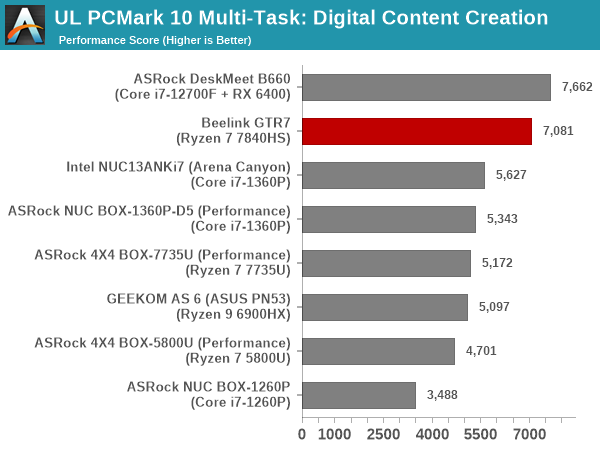
| UL PCMark 10 Load Testing - Productivity Scores | |||
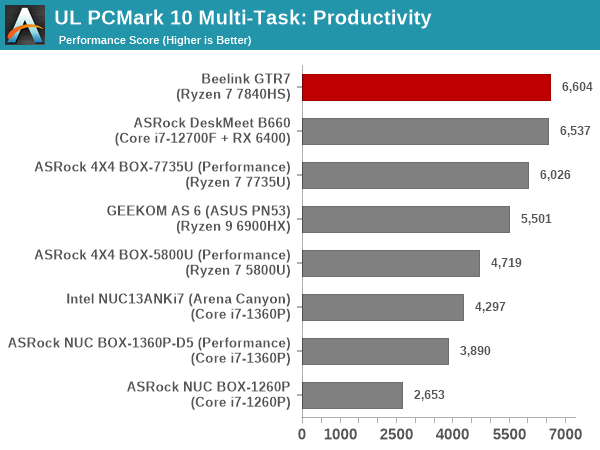
| UL PCMark 10 Load Testing - Essentials Scores | |||
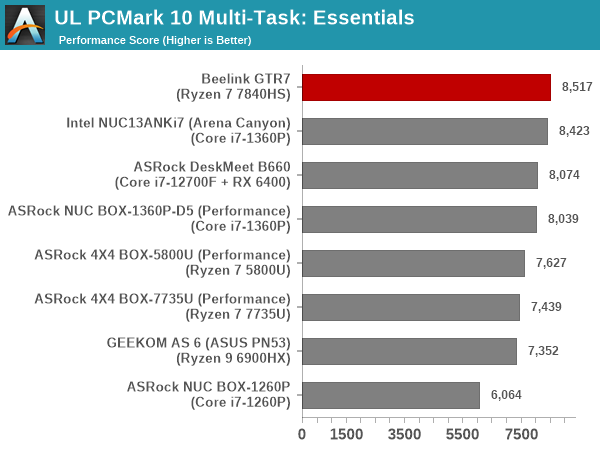
| UL PCMark 10 Load Testing - Gaming Scores | |||

| UL PCMark 10 Load Testing - Overall Scores | |||

Configuring the GTR7's Phoenix SoC at 65W gives it plenty of headroom to tackle multiple concurrent demanding workloads triggered by mainstream users (of the type benchmarked by PCMark 10). The GTR7 was already having leading performance in the absence of concurrent loading. Activation of such loads reduces the raw score, but the performance loss is less than the competition, and the GTR7 continues to remain on top.
Following the completion of the PCMark 10 benchmark, a short delay is introduced prior to the processing of Principled Technologies WebXPRT4 on MS Edge. Similar to the PCMark 10 results presentation, the graph below show the scores recorded with the transcoding load active. Available for comparison are the dedicated CPU power scores and a measure of the performance loss.
| Principled Technologies WebXPRT4 Load Testing Scores (MS Edge) | |||
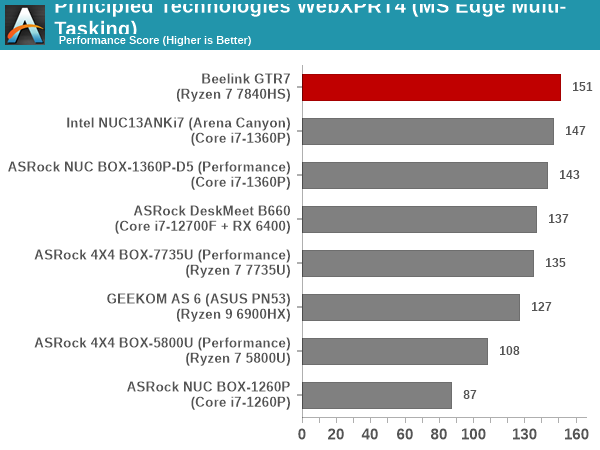
The observations made for the overall PCMark 10 scores continue to hold for WebXPRT 4 also. The GTR7 has the least performance loss, and that allows it to leapfrog the RPL-P systems in performance.
The final workload tested as part of the multitasking evaluation routine is CINEBENCH R23.
| 3D Rendering - CINEBENCH R23 Load Testing - Single Thread Score | |||

| 3D Rendering - CINEBENCH R23 Load Testing - Multiple Thread Score | |||
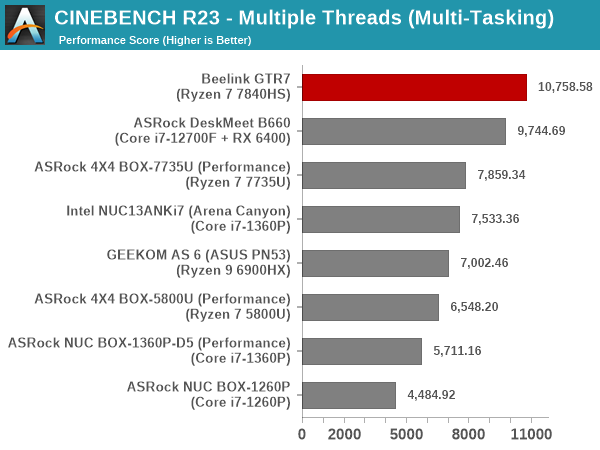
Intensive background tasks keep the efficiency cores busy, and take up some of the power budget. As a result, while the RPL-P systems came out on top in the absence of the background loads in single-threaded mode, the AMD-based systems manages to outwit them in raw scores after the introduction of the load. Multi-threaded performance continues to be a strongpoint of the GTR7, with the system coming out on top irrespective of the concurrent loading.
After the completion of all the workloads, we let the transcoding routine run to completion. The monitored transcoding rate throughout the above evaluation routine (in terms of frames per second) is graphed below.
The transcoding rate during different segments is also recorded below.
| Beelink GTR7 (Ryzen 7 7840HS) ffmpeg Transcoding Rate (Multi-Tasking Test) |
|||
| Task Segment | Transcoding Rate (FPS) | ||
| Minimum | Average | Maximum | |
| Transcode Start Pass | 2.5 | 14.12 | 46.5 |
| PCMark 10 | 0 | 13.99 | 44.5 |
| WebXPRT 4 | 6.5 | 13.63 | 23 |
| Cinebench R23 | 5 | 13.78 | 48.5 |
| Transcode End Pass | 5.5 | 14.8 | 45.5 |
The comparison is against RPL-P systems such as the NUC BOX-1360P/D5. The GTR7 has a much lower delta in the transcoding rate between different task segments, but the power budget ensures that it doesn't translate to a lower primary workload score as seen in the graphs above. Overall, the RPL-P systems seem to prioritize foreground task better compared to AMD systems, but with the right power budget, the end user may not even notice the aspect.


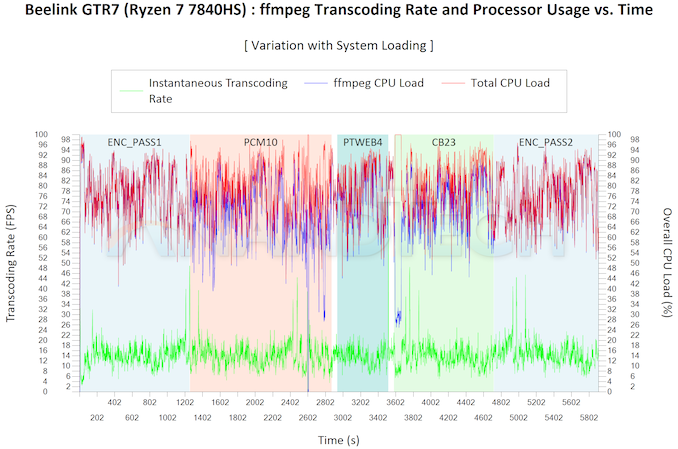








56 Comments
View All Comments
ganeshts - Friday, August 25, 2023 - link
The fan shown in the photo is for the RAM and the SSD (please take a look at the picture in the thermal characteristics section for more context on where that fan goes in the overall system).The fan behind the heat spreaders connected to the vapor chamber is not pictured in the article, but available in the cross-sectional view on Beelink's product page:
https://img.bee-link.com/media/upload/5/o2/5o29ppo...
It is a typical notebook fan, and combined with the vapor chamber, it is effective enough to handle the 65W cTDP setting.
abufrejoval - Friday, August 25, 2023 - link
"pro" vs. "non-pro" in APU or Ryzen G parlance used to indicate support for ECC RAM, which for some reason was *not* included for the APUs vs the "normal" Ryzens.So my question here is: does the Pro variant (with a Ryzen 7 7845) support ECC RAM?
Because that's pretty much the only remaining item on my wish lilst for this class of machine (well, I'd rather have them as Mini-ITX, but that doesn't seem to happen).
abufrejoval - Monday, August 28, 2023 - link
Just in case somebody else wonders: Pro vs. non-Pro evidently is no longer a differentitator for ECC support on the Phoenix series APUs. It's all in the "socket" or rather package; FP7 and FP8 do not support ECC while FP7r2 *can*, if the platform does, independent of the particular chips (Ryzen 3 vs 9) or the "Pro": each chip is available in each "socket" or form factor...And to muddy the waters even further, you can't tell the "socket" from the branding/model, I supposed there is a part number that will tell you but for a device like this, you'd mostly have to hope that the vendor will tell you.... fat chance, I'd say from past experience.
And looking at the *5 parts, I noticed that for Phoenix this is used to indicated the desktop die derived high-TDP mobile parts using the FL1 "socket": while the desktop chips generally support ECC, these mobile workstation parts absolutely do not, most likely because the FL1 "socket" otherwise would have required a couple of extra traces...
Sometimes I'd like to have a word with AMD's cost cutters, beause they keep cutting into vital flesh and kill entire market niches with their excess.
abufrejoval - Monday, August 28, 2023 - link
Digging further (sorry), the availability of DDR5 sockets seems to indicate FP7r2: FP7 and FP8 seem to be exclusively (soldered) LPDDR5.There are SO-DIMM 32GB, DDR5-4800, CL40-39-39, ECC, on-die ECC modules available from Kingston which are listed as dual-rank x8, while AMD lists "4x2R" support...
Ganesh if you happen to have some ECC DDR5 SO-DIMMs available I'd be really thankful for a test!
And the Dragon Range (desktop derived) FL1 "socket" parts definitely do not support LPDDR5,only (SO-)DIMMs but still no ECC....
jepo - Friday, August 25, 2023 - link
I bought one of these with the 7940HS via Aliexpress (679 gbp) in July after the review in ServeTheHome. It arrived in 2 weeks, same spec as this review except the 7940HS and mine is grey. I added an extra 2Tb Samsung 990 Pro SSD. To my surprise on first boot it has Windows 11 Pro installed. I gave it a CPU bound process to do that I expected to take 2 weeks given that is how long it would take on my 4 year old 3900X 12 core desktop. It completed in 10 days. During that time it was 100% CPU all cores. Yes the fan is quite noisy, but there was no throttling. In my opinion it's a great little box, and I've changed to use this as my main dev machne.shiromar - Monday, August 28, 2023 - link
I am consider something small and powerful for gen 7 game emulation. can this beelink handle the gen7 stuff?Also i would really like to install steamOS via holoiso. Does anyone know if this GPU plays nice with holo?
thanks